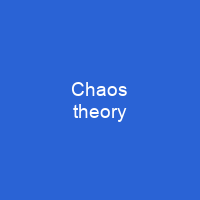Chaos theory is an interdisciplinary theory stating that, within the apparent randomness of chaotic complex systems, there are underlying patterns, interconnectedness, constant feedback loops, repetition, self-similarity, fractals, and self-organization. Chaotic behavior exists in many natural systems, including fluid flow, heartbeat irregularities, weather and climate. It also occurs spontaneously in some systems with artificial components, such as the stock market and road traffic.
About Chaos theory in brief

Within this picture, all systems have significantly different future paths or trajectories. Sensitivity to initial conditions means that each current trajectory of the current system may lead to significantly different behavior in the long-range future. This picture is an important generalization from the physical point of view of reality, since all systems experience an arbitrarily large change or perturbation in their environment from time to time. In the discrete-time case, this is true for all continuous maps on metric spaces. If attention is restricted to intervals, the second property implies the other two. In chaotic systems, the uncertainty in a forecast increases exponentially with elapsed time. This means, in practice, a meaningful prediction cannot be made over an interval of more than two or three times theLyapunOV time. When meaningful predictions cannot be make, the system appears random. This behavior is known as deterministic chaos, or simply chaos. It can happen even though these systems are deterministic, meaning that their future behavior follows a unique evolution and is fully determined by their initial conditions, with no random elements involved. In some cases, the last two properties above have been shown to actually imply sensitivity toinitial conditions. In these cases, while it is often the most practically significant property, it is not stated in the definition of ‘chaos’ The theory was summarized by Edward Lorenz as: Chaos: When the present determines the future, but the approximate present does not approximately determine the future.
You want to know more about Chaos theory?
This page is based on the article Chaos theory published in Wikipedia (as of Dec. 06, 2020) and was automatically summarized using artificial intelligence.







